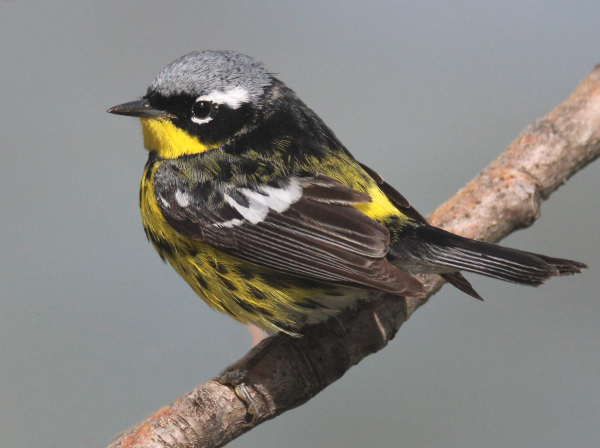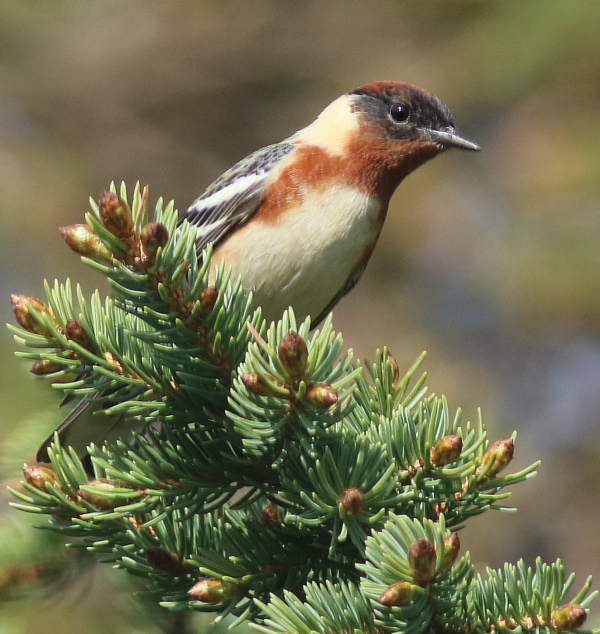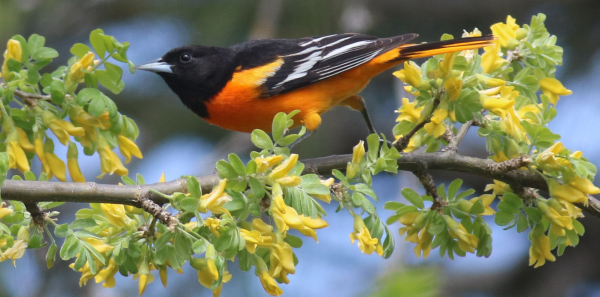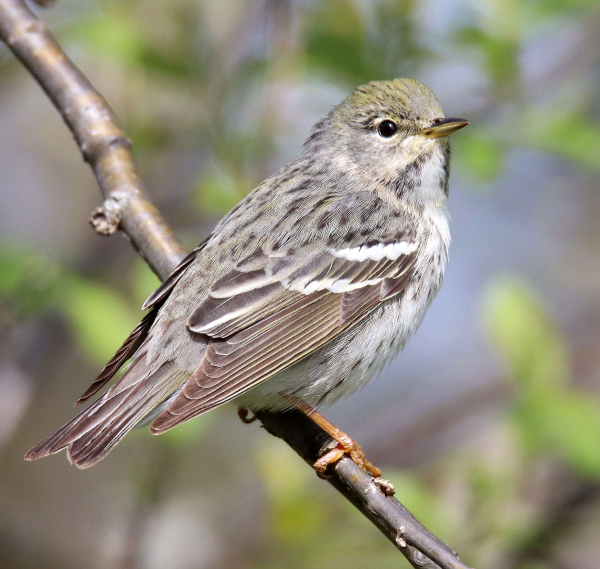This week migrating songbirds will be spreading across every state in the Lower 48 and reaching borderlands of southern provinces. Among the variety of songbirds, the many small colorful warblers tend to be the group that sends birders into renewed levels of excitement, binoculars and cameras in hand. No other group of birds tantalizes us during May more than the colorful warblers and other songbirds that race northward, partly because they may be the most difficult group of birds to photograph.

It’s rare when you get the opportunity to photograph a warbler with an unobstructed background, but you might be able to entice warblers to a bare perch that you add at an unobstructed location (Magnolia Warbler photographed with a lens zoomed to 310mm, f-6 aperture, 1/2500 shutter speed, ISO 800).
|
They are small, they move fast, and they tend to prefer treetop branches, leaves, and flowers, making photographing these active dynamos a force to contend with, when you find them. It’s time to take advantage of the chances to photograph songbirds making a migration stop for a few hours or a few days between their Latin American wintering areas and their summer range in northern forests. This is especially true for those of us who have a special attraction for the small colorful active songbirds – especially warblers, orioles, tanagers, buntings, vireos, grosbeaks, and more.
To be most successful, it takes time in the field, spending time in one place, making the rounds, checking places where you’ve had migration encounters before, searching out new locations, and enjoying every minute of it – including the time you spend reviewing photos at the end of the day and marveling at the birds you photographed and the remarkable photographs you created. It’s exhilarating when you are in the moment with your camera, as well as when you see the results on your computer or tablet screen.
Best Photo Options – Ideally, we are looking for birds that are fairly close, foraging at or near eye level in good lighting – Ideally. I try to avoid photographing small songbirds that are active high in the trees, or in deep shade, or birds that are too far away. I always try to move slowly and deliberately when I’m around birds I’m interested in photographing, trying to be of least concern to the birds; trying hard not to change their behavior.
Follow the Action – When I’m on foot and find an interesting songbird, I like to try to follow it as it moves through the bushes, trees, and plants. In some cases you may be able to follow a special bird for a couple hundred feet, hopefully able to take photographs of it along the way. At times I slip ahead of the bird to wait for it to catch up to me as it forages in a given direction.
Watch for an Opening – When you follow a songbird in motion, watch for openings in the leaves, twigs, and branches where they might emerge into a sunny opening for the best chances to take good photos. Pre-focus and try to anticipate their next moves.
Anticipate – When photographing a foraging songbird, try to anticipate its route, where it will appear next. Then while photographing it, use your fastest reflexes to photograph while anticipating the birds next head turn, hop, stretch, and move.
Find a Magnet – A blooming tree can be a magnet for songbirds that are looking for the small insects attracted to the flowers and new leaves. But in some cases, like for orioles and hummingbirds, they may get some nectar nourishment from the flowers too. It’s often worth spending a little extra time near a blooming tree when songbirds are in the area, and it can be worthwhile to check back periodically.

A part of a spruce branch adds to the quality of this Bay-breasted Warbler image, in which the background is out of focus (400mm telephoto, f-7 aperture, 1/800 shutter speed, ISO 400).
|
Bring Lotsa Luck – Take a lot of photographs when you have chances with songbirds; they move so fast, by the time you react they can change positions, even leave the scene. Bring a bucket ‘o luck, and appreciate that you will have many misses and a few successes each time you photograph migrating songbirds.
Weather Forecasts – Plan your hours afield, as well as any May birding trips you have in mind, with an eye on the weather report. We want to photograph when sunlight will provide the key ingredient in any successful photo – beautiful natural light. Plan your photo periods when sunlight is available; avoid cloudy weather, because you will be disappointed with the quality of the photos you take, especially related to the dull colors of the birds.
BirdCast Forecasts – In addition to weather reports, keep an eye on BirdCast for migration predictions and overnight radar feedback.
Timing – During this time of year, take advantage of sunny periods each day, primarily between 7am and 11am, and again from 3pm to 6pm. That’s when the sun is positioned between a 45- to 30-degree angle that best illuminates birds with less chance of shadows forming on the underside of the birds, all while providing the best natural colors of birds you are photographing.
Sun Angle – To determine the angle of the sun above the horizon, straight overhead is 90 degrees, the horizon is 0 degrees. Therefore, when the sun is positioned between these angles – from 45 to 30 degrees, and maybe down to 20 degrees in some cases – that’s prime photo time in my book.
Lighting – Position yourself between the sun and locations where you expect to find birds, or places where you see birds. Photography is all about the light, and for me, I am only confident in my bird photography when I have full sunlight at my back with an angle of 45- to 30-degrees above the horizon – because I’m usually disappointed with the results I get otherwise. Therefore I’m passing that information on to you to use (or ignore) for greater successes in the field.
The Shadow Knows – A simple test to make sure you are positioned to use the best sunlight is to make sure your shadow is pointing as directly at your subject as possible. And remember to re-check your shadow periodically, in case you lose track of your direction and your position relative to the direction of the sunlight.
Document First – Of course, when you find a songbird you have rarely if ever photographed before, be sure to take at least one documentary photo to begin with, then try to upgrade to better images as opportunities permit. Don’t hesitate; take at least an initial photo, then wait for better positions that may or may not materialize. Actually, that’s a good plan when photographing any birds.
Background Awareness – Try to keep aware of the background of your photo too. Try your best to eliminate twigs and grass especially, which can be done with some success by reducing the area of focus (depth of field) to throw the background out of focus. Watch for twigs or branches that you may be able to avoid by leaning left or right, up or down; or taking a step in another direction.

Although it contributed to a pleasing uniform background color, the aperture was too narrow in this Blue-gray Gnatcatcher photo in which its eye is in perfect focus, but the tail is out of focus (500mm zoom, f-6 aperture, 1/640 shutter speed, ISO 800).
|
More Background Awareness – Stay aware of the background behind the bird. Photos are usually best if the background is unobstructed or uniformly colored, as when the sky or water provides a fairly uniform background. Also, the more space between the bird and the background, the better the likelihood that the background will be out of focus when using a narrow f-6 or f-4 aperture.
Shadow Awareness – Sunlight creates shadows, and while your timing can help reduce the effect of shadows on the birds and plants, be aware of the shadows on and surrounding the birds you photograph. As much as possible, try to keep aware of shadows created underneath the birds or on one side or the other, as well as shadows on the birds that are created by leaves and twigs around them. It’s tough to watch for shadows when the birds are moving so quickly, but it’s all part of the things to keep in mind as you are photographing, most of which become second nature with time.
Steady Freddy – While photographing songbird action, be sure to hold your breath when you press your shutter button, and steady your lens on whatever is handy when you can – the window frame of your mobile blind, a tree trunk or branch, a fence post, or pull your elbows into the sides of your body to help steady your camera-lens combo.
Tripod Trepidations – If you use a pop-up tent-style blind or a similar non-mobile option, you can set up a tripod, although a tripod always adds another level of difficulty when trying to follow the frivolous or frantic movements of warblers and other songbirds.
Vibration Compensation – My Tamron 150-to-600 zoom lens has vibration compensation, a wonderful feature that helps to eliminate some level of body shake while helping me to eliminate a tripod, even when using the lens at 500mm and 600mm magnifications.
Image Stabilization – Some companies call similar technology image stabilization, and these features are most helpful in reducing bodily vibrations and other slight movements.
First Edit – One of the keys to photographing spring migrants of any kind is to take a lot of photographs, then review your images when you return home, selecting and editing the good photos, deleting obvious bad photos, and filing the rest away for future reference, or posterity.
Final Edit – My final edits are usually a matter of selecting the very best photos, then making a copy of each digital image that I name, crop, and file. If a photo makes my final edit, I only need to crop extraneous surroundings out of the background to improve the original photo.

TECHNICAL SUGGESTIONS
Center Focus – One thing that I found to be especially helpful when photographing songbirds on the move was to choose the center focus option of the autofocus (AF) setting.
Following with Autofocus – Warblers and other small songbirds are usually constantly on the move, foraging between leaves and twigs and flowers, and they are quick; so do your best to follow them, try to let your camera’s autofocus help to keep them in focus during the process, and take lots of photos.
Manual Focus – It’s worthwhile to note that sometimes you may want to switch to manual focusing if vegetation tests the limit of the auto-focus. Manual focusing might prove even less fruitful when trying to keep up with the movements of foraging warblers, but it’s always an option.
Aperture – The blurred effect helps to emphasize your subject, and is accomplished by setting your aperture to a narrow f-5 or f-6. That aperture should keep your bird in focus while blurring the background and foreground at least somewhat.
Aperture Priority – I always recommend using the Av (aperture priority) setting on your camera’s Mode Dial; then set the f-stop, and the camera will automatically provide the corresponding shutter speed as you photograph. I suggest never using automatic settings, but the aperture priority setting is most helpful and keeps you involved in the decision making.
Shutter Speed – Using a narrower the aperture setting, say an f-6, coincidentally provides a faster shutter speed, which is helpful in stopping the motion of fast-moving songbirds and providing you with sharp images.
ISO Too – I usually use a 400 ISO setting, but sometimes I opt to use an 800 ISO due to a predominantly dark vegetation reading or when shutter speeds are too slow with ISO 400.
A LOCAL SONGBIRD HOTSPOT

Not all warblers are extra colorful, but a sharp photograph of a bird like this female Blackpoll Warbler allows you to study the subtle colors and markings that add to its spring portrait (600mm telephoto, f-6 aperture, 1/2000 shutter speed, ISO 800).
|
Find Your Hotspot – All birders need to find a hotspot or migration fallout location that you know attracts migrating songbirds annually. At the same time, be on the lookout for other potential hotspots each May. Appreciate that some locations are good some years, and not others; some sites are good some days, and not others. In my local area, I have 3 primary songbird hotspots, but only one is reliable year after year – I call it Melody’s Grove.
My Local Hotspot – Melody’s Grove is just 200 yards away from my home, and it attracts a variety of migrating warblers, orioles, thrushes, thrashers, catbirds, flycatchers, and hummingbirds during short mid- and late-May stopovers. What fun and what successes I’ve had photographing these birds at “The Grove” each May!
Grovin’ – Because it’s so close, I check on any birds that may be present at Melody’s Grove daily, usually a couple times a day. Some days are duds, some are active, some are fantastic! When birds are present, I tend to spend a couple hours on site at a time, but stay as long as the birds dictate. Usually midday is slow, and that’s when the lighting is much less usable, so even on good days I tend to make 2 primary visits to photograph, during morning and late afternoon as sunlight permits.
Using a Mobile Blind – You probably already know that I like to use my vehicle as a comfortable mobile blind. Birds tend to react to people, but mostly ignore a parked vehicle. At Melody’s Grove I can pass along the edge of the trees, where songbirds are bathed in sunlight as they feed along the side of the trees and bushes and move into the adjacent grasses. I have a few favored places to park, sometimes next to a flowering tree, other times where open perches favor photography.
Mobile Blind Lighting – I check photo conditions on the east side of The Grove in the morning when the sun is shining, then switch to the northwest side of the grove during late afternoon to utilize the sunlight as the sun begins setting.
Totally Mobile – When I see repeated birdy action farther ahead along the grove, I merely start my mobile blind and ease forward to try to get in a better position to photograph a given bird or a feeding group of birds. When the action subsides, I shift into reverse to reposition at another location.
Stay Hidden – I have limited luck when I walk along the same areas of Melody’s Grove; songbirds tend to react to me as a human, whereas they disregard my car or van. Of course, any time you are photographing from inside a vehicle, be sure to turn off the engine to avoid motor vibrations, and to keep birds from reacting to the sound of the engine.
As I have written this article, I’ve become more and more excited; soon the best time to photograph migrating songbirds will be upon us and it will get better and better throughout the month of May! Get ready, be ready, and have fun, time and time again! Oh, and Good Luck!
Article and photographs by Paul Konrad
Share your bird photos and birding experiences at editorstbw2@gmail.com